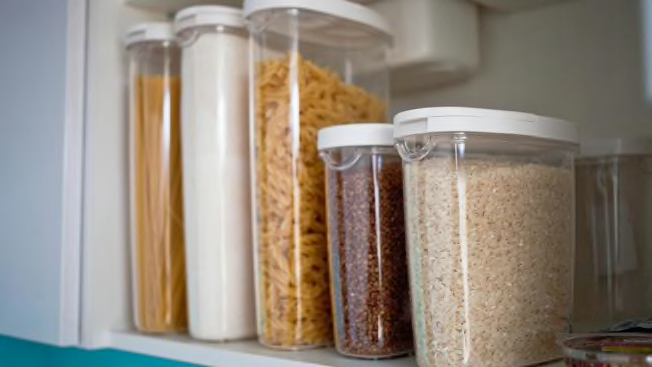How to Organize a Pantry
Strategies to map out where your nonperishables should go and which containers to keep them in

Meticulously organized pantries are often a coveted feature at home. We’ve seen a range of styles, from color-coded systems for packed pantries to minimalist displays that look like a storefront. But it takes a lot more than just a set of uniform containers to whip the clutter-prone area into shape. Planning and a willingness to maintain organization are just the start.
Consumer Reports enlisted the help of organizing professionals for their insight on the most effective ways to tackle this problem area. Here’s what to think about when shopping for pantry storage items.
Pantries can be littered with items for “maybe someday use” or random packages with a single cookie left in them, says Karin Socci, founder of The Serene Home. To declutter the area, think about what you’ll use on a daily or weekly basis and make those accessible. The size and shape of a pantry will inform the best approach to tidying it up; a dedicated storage room will require a lot more gear than a cabinet or cupboard will.
Start With a Plan
First, make sure you give yourself plenty of time for the task. One of the biggest organizing mistakes people sometimes make is underestimating how long the entire process can take, says Aline Lau, certified KonMari (a decluttering method developed by Marie Kondo) consultant and founder of Tokimekie.
Running out of time and having to put everything away before the task is finished can cause a worse situation than there was in the beginning. “Setting a whole day aside is more realistic, and if you finish early, then it is a bonus,” Lau says.
Pro tip: When resupplying not-yet-empty canisters, temporarily pour out the existing contents and put the fresh goods in the bottom of the vessel, then top it off with what was already in the container, so you’re using whatever is older first.
What to label: Systematically labeling every item in a pantry may look good, but there’s no need to tag oats as “oats” when it’s clearly that. Instead, jot down the product’s expiration date or when it was purchased.
Where to place: “It’s important to designate where each category will live,” Lau says, and preserve it for that purpose alone, even if it’s temporarily empty. If you don’t, your pantry will remain organized only until your next grocery trip.

iStock-1198696341 iStock-1198696341
How to Store the Basics
Once you have a general idea of what you’re keeping and where it will go, think about the best way to display it in your pantry. Here’s what the experts recommend.
Dry goods: Grains, cereal, and pasta (plus anything else that is purchased in bulk) tend to occupy a good chunk of our pantries, so pouring them into uniform containers can be helpful.
Lau’s go-to containers are Bormioli Rocco’s Fido jars (from $5 at Sur la Table; $30 for a set of three at Amazon), which can be used for storing anything from pasta to dried beans. For staples often bought in larger quantities—such as cereal, oats, and rice—stackable canisters ($30 at Amazon; similar set for $25 at Amazon) or basic jars can help maximize shelf space.
Baking ingredients: How often you bake will dictate the amount of space you need for the ingredients and where they should be in your pantry, Socci says. If you bake frequently, consider creating a zone where you can store dry ingredients along with related equipment.
Decant bulky bags of flour and sugar into airtight containers to keep them from absorbing the odors around them. Their original packaging tends to break and spill if you use them often. If you’re storing them in a cool, dark area, you can get away with using clear canisters; otherwise, go for an opaque option. For smaller items, like baking powder cans or bottles of sprinkles, Lau suggests corralling them into a divided Lazy Susan ($27 at Amazon).
Spices: Organizing spices can be quite a feat, but it depends on how many you have and where you’ll store them. On a shelf, the three pros we talked to agree that an expandable tiered organizer ($26 at Amazon; similar model for $20 at Wayfair) is best because it will keep the jars visible while maximizing the amount of available storage space. In drawers, similar tiered structures or dedicated racks can achieve the same effect. A drawer organizer ($22 at The Container Store; $20 at Bed Bath and Beyond) with adjustable sides is one place to start.
If you don’t have the drawer space, there are plenty of other alternatives, such as wall-mounted spice racks and over-the-door organizers for cabinets or pantry doors. There are even magnetic jars that can stick to the side of the fridge.
If the spices will be stored in a cabinet, turntables can provide 360-degree visibility and accessibility—Lowenheim prescribes a nonslip turntable (from $13 at The Container Store; $13 at Amazon).

GettyImages-83191435 GettyImages-83191435
Canned staples: Make your life easy and stack canned goods on top of one another, keeping them clustered in a dedicated area of the pantry. If you’re looking for a minimalist fix that promotes visibility and a neater arrangement, Lau suggests a three-tier shelf ($30 for one that expands up to 19 inches wide at The Container Store; a model that expands up to 25 inches for $15 at Bed Bath and Beyond).
Snacks and drinks: Bins are an easy way to keep track of loose snack bags, chips, and various other individually packaged goods. Socci recommends metal baskets ($20 at Amazon) or clear fridge storage bins ($23 at Amazon; similar models from $4 at Bed Bath and Beyond), which can also be used to hold canned and bottled beverages.
Bottled items: Whether it’s oils, vinegar, or an ever-growing collection of shelf-stable condiments, these pantry staples will rarely require decanting. Instead, you can devise a way to corral them in one spot, making them easily accessible. A turntable is ideal for cabinets, while a walk-in pantry with shelves can benefit from transparent bins. “A storage system isn’t good if it’s full of items you can’t see or don’t need,” says Socci, who recommends these easy-to-clean containers ($35 at Amazon) that are great for storing oil bottles and come with convenient built-in handles.
At the end of the day, it’s not all about looks—a pantry should be accessible and easy to use. Set the proper expectations for the space by employing an organizational system you’ll be able to regularly maintain, and keep in mind that it’s going to be a constant work in progress.
















